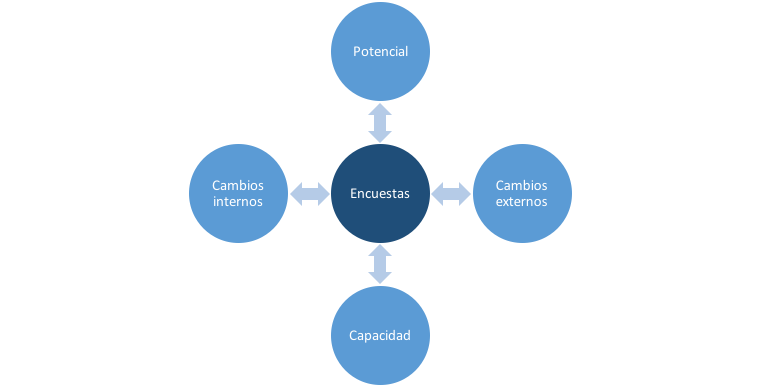Over the past few years at Openmet, we’ve noticed a rise in the frequency of our client and employee evaluation projects and studies. They’re becoming more and more frequent, and this trend cuts across both client surveys (e.g., NPS surveys, de customer experience surveys or satisfaction surveys), and HR evaluation projects (e.g., work environment surveys, competency assessments or 360º, or internal satisfaction surveys).
In this post, we want to explain the reasons behind this market dynamic and highlight the key points to consider when defining a proper temporal strategy for periodic survey projects.
Why Surveys are Conducted More Frequently?
We’ve identified several reasons driving this trend:
1. Management Maturity
Companies are increasingly aware of the need for relevant information to better understand their surrounding reality, aiming to make management decisions based on real data. As a result, customer or employee evaluations through surveys are becoming more crucial within companies. What used to be sporadic projects (annual or biannual) are now evolving into continuous and periodic processes.
2. Growing Demand and Competitive Expectations
In a highly competitive, dynamic, and digitized environment, both customers and employees expect to interact with companies that respond quickly to their demands and issues. Inaction or delayed responses are perceived as incompetence, leading customers and employees to believe that other companies will offer better services.
3. Technological Advancements
Electronic surveys make the automated conduct of surveys more economical and straightforward, and data analytics software allows for instant results without requiring extensive resource hours or consultancy to interpret the findings.
The trend towards conducting surveys more frequently emerges as a solution to these dynamics. However, the question our clients often ask is: What is the appropriate pace for capturing data? How often should surveys be repeated?
Ideal Survey Frequency
The frequency of surveys ultimately depends on the need for data and our ability to obtain it.
1. The need for data depends on how quickly what we are measuring changes. Naturally, we only need to measure what changes. In other words, it is inefficient to measure what we know remains constant.
Therefore, the frequency with which we need to repeat a survey will depend on:
a) Uncontrolled internal changes in what we are measuring: If our relationship with customers or employees is subject to constant changes in the conditions we want to monitor, then it will be necessary to align evaluations with the pace of these changes. For example, if we want to accurately assess the NPS index of a service that exhibits marked annual seasonality, we cannot limit ourselves to conducting an evaluation once a year. Instead, evaluations need to be conducted at various times throughout the year to truly understand what occurs in each “season.” Failing to do so could lead to decisions based on data from a specific moment, which likely wouldn’t be representative of other seasons.
b) External changes we induce in what we measure: Regardless of internal changes, the company induces variations in what we measure through its actions, altering interactions with customers and the characteristics of the service and/or products offered. This ability to induce changes depends on how quickly the company can evaluate what we measure, analyze the results, make improvement decisions, execute them, and have them experienced by customers or employees. Until this last point occurs, there will be no change in the perception of customers or employees, and therefore, we cannot expect what we measure to change substantially due to these actions. For example, if a company takes 6 months to define and implement improvement action plans related to the work environment, it would be inefficient to conduct work environment surveys every 3 months because nothing would have changed during this period (unless, of course, there are internal changes justifying it).
2. The potential and capacity to obtain data depend on the speed at which we can create and receive responses to surveys, which has two components:
a) The potential or maximum rate at which we can ask questions to customers or workers. Even if we wanted to and it made sense, we probably couldn’t conduct a satisfaction survey every hour because the people who have to respond would become annoyed. There are some strategies that can help increase the surveying rate without causing annoyance, such as conducting very short surveys (one or two questions) or not surveying the entire population, but only a partial sample that can rotate, so the same person will take some time to receive a new survey. In any case, the maximum rate will always be limited by the willingness and availability of individuals to respond.
b) The company’s economic and technological capacity to conduct a high number of surveys. The cost of a periodic survey program can be high, especially in the case of non-electronic surveys (e.g., phone or in-person). The technological capacity to access and integrate the necessary data to conduct the survey can also limit the surveying rate.
Once these concepts are defined, we will need to find the survey frequency that optimizes the 4 factors on which it depends (internal changes, external changes, potential, and capacity).
Conclusion
The frequency of surveys should not be chosen randomly but should be the result of careful consideration, taking into account at least the following aspects:
1. The speed at which what is being evaluated naturally changes
2. The speed at which the company wants and can react to the results obtained in order to decide and implement the action plan that generates changes in what is being evaluated
3. The potential for customers and/or workers to respond to surveys
4. The company’s economic and technological capacity to conduct a high number of surveys





